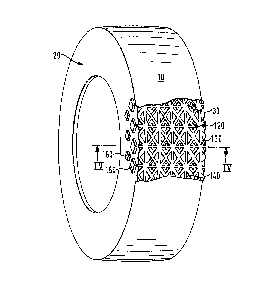Note: Descriptions are shown in the official language in which they were submitted.
Z~3 E;2i4
This invention relates to a tire tread and is more
particularly directed to noise reduction, improved heat
distribution -to lengthen the useful life of a tire and to
the removal of snow and water from the road engaging
surface.
The development of tire tread designs to improve
the operational parameters of tires such as handling,
braking, and control has seen the development of many
tire tread designs. Diamond-shaped and triangular-shaped
tire treads have been used in various arrangements in
tire tread designs. The Roberts patent number 4,221,254,
for example, utilizes a plurality of circumferentially
spaced triangular tread projections. A transverse groove
and triangular blocks may be seen in the Verdier patent
15 number 3,998,256.
The following is a list of prior art presently
known;
Number Date Inventor For
2,479,958 Aug.23,1949 Norman,Jr. Tire Tread;
20 3,986,545 Oct.19,1976 Montagne Tire Tread;
3,998,265 Dec.21,1976 Verdier Tire with Tread
Blocks Having
Identical, Circular
Ellipses of Inertia ;
25 4,221,254 Sep.9,1980 Roberts et al.Tread for Pneumatic
Tire;
4,279,283 Jul.21,1981 Hitzky High ~erimeter Tread
Element;
4,299,264 Nov.10,1981 Williams Tires;
30 4,481,991 Nov.13,1984 Pieper Tread Configuration
for Motor Vehicle
Tires;
D 59,755 Nov.22,1921 Kilborn Tire;
D 63,645 Jul.13,1923 ~loffstaedter Automobile Tire;
35 D 68,978 Aug.26,1924 Litchfield Tire;
D 76,886 Nov.13,1928 Nesmith Tire;
D 79,686 Jan.28,1929 Hower Automobile Tire;
D 92,569 Sep.11,1933 Anderson Vehicle Tire; and
D215,133 Sept.2,1969 Porten Pneumatic Tire
The invention utilizes a tire tread construction
which improves distribution of excess heat, dampens road
noise and removes snow and water from the road engaging
.. .. .
`''' ''
Z~ 4
-- 2 --
surface of the -tire. A rectangular tread block, having
major and minor sides, is divided by diagonal grooves to
form four triangular lands. The rectangular tread block
units are arranged in circumferentially and transversely
spaced apart columns and rows. A circumferentially orien-
ted sipe extends from every minor side as a groove toward
the center of the triangular land area. This sipe provides
improved heat removal, noise dampening and water removal
of the tire tread. The diagonal grooves in the tire tread
blocks are aligned so as to form transverse diagonal
grooves. The circumferential transverse and diagonal
grooves provide for the disbursement of water and snow
from the triangular land areas.
Diamond shaped tire treads are disposed on the tire
sidewall adjacent the road engaging surface of the tire
to provide for improved handling under conditions when
the sidewalls are in contact with the road surface.
This combination of tire tread components maximizes
the heat disbursement characteristics of the tire tread
by using diagonal, transverse and circumferential grooves
which also disperse snow and water. The sipe provides
improved heat and water disbursement and improved noise
dampening of the triangular lands disposed on the minor
side of the rectangular block.
Other objects and advantages of the invention may
be had from the following description of an illustrated
preferred embodiment and method as shown in the appended
drawings in which;
Figure 1 is a partial perspective view of a tire
tread embodying the principles of the invention;
Figure 2 is an enlarged plan view of a portion of
the tire tread;
Figure 3 is an enlarged plan view of a section of
the tire tread surface;
Figure 4 is a cross section view of the tire taken
214
along plane 4-4 in figure 1.
A tire 10 is divided into a sidewall section 20 and
a road engaging surface 30. The road engaging surface 30
is the portion of the tire body 10 which under normal
conditionsis in contact with the road surface. The side-
wall section 20 of the tire body 10 is the portion which
connects the road engaging surface 30 to the beads on a~
tire that is mounted on the rim of a wheel.
Figure 2 is a plan view of a rectangular tread
block unit 40. The rectangular tread block unit 40 has
major sides 60 and minor sides 70. Rectangular tread block
40 is divided into triangular lands 80 by diagonal
grooves 140 which extend between opposing corners of
rectangular tread block unit 40. In one preferred embo-
diment, the triangular lands 30 at minor sides 70 areconstructed as equilateral triangular lands 90 and the
triangular lands 80 with major sides 60 are constructed
with isosceles triangular lands 100.
A sipe 110 is grooved into the triangular lands
90 from the midpoint of the minor sides 70. The groove
; of sipe 110 extends approximately one fourth the distance
from minor side 70 to the opposing corner of triangular
land 90.
As shown in figure 3, rectangular tread block units
25 40 are spaced such that transverse grooves 120 and cir-
cumferential grooves 130 are formed, and so that the dia-
gonal grooves 140 of the rectangular tread block units
40 are in axial alignment. Each side of road engaging
surface 30 is comprised of a plurality of similarly
spaced apar-t rectangular block units 50 which are appro-
ximately one-half of the width of rectangular block units
40. The widths of circumferential grooves 130 and dia-
' gonal grooves 140 are substantially equal. The width of
the groove in the sipe 110 and the transverse groove
are also substantially equal and approximately one-half
621~
the width of circumferential groove 130 and diagonal
groove 140.
As shown in figure 1, a first plurality of spaced
apart diamond shaped lands 150 are located on the tire
sidewall 20 adjacent the road engaging surface 30. Each
of the first diamond shaped lands 150 are centered on
each -transverse groove 120. A second plurality of spaced
apart diamond shaped lands, 160, are disposed on tire
sidewall 20 adjacent to the lands 150. Diamond shaped
lands 160 are of approximately one-half the size of
diamond shaped lands 150. Diamond shaped lands 160 are
positioned further up the tire sidewall 20 and between
adjacent diamond shaped treads of diamond shaped lands.
